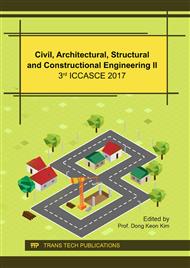p.89
p.95
p.104
p.110
p.115
p.121
p.126
p.135
p.140
Using of Plastic Hinges in the Calculation of Buildings against Progressive Collapse under Fire Exposure
Abstract:
This article presents a study of the strength of a 25-storey reinforced concrete frame against progressive collapse in fire conditions. Taking into account the angles of disclosure of plastic hinges as norming for the strength of reinforced concrete elements, a computer technology program has been developed and included in PR Wolfram Mathematica 10 for the dynamic calculation of compressed reinforced concrete elements under fire exposure on the basis of the conducted experimental studies. Dynamic calculation of the strength of eccentrically compressed reinforced concrete columns was carried out, with operation in normal conditions and under high temperatures. The diagram «moment-curvature» and the graph of the change of the static and dynamic strength of the column depending on the temperature were developed. Nonlinear dynamic analysis of a 25-storey reinforced concrete frame was conducted, taking into account the changes of the dynamic characteristics of reinforced concrete elements in fire and, the estimation of resistance of the frame was given.
Info:
Periodical:
Pages:
115-120
Citation:
Online since:
February 2018
Authors:
Price:
Сopyright:
© 2018 Trans Tech Publications Ltd. All Rights Reserved
Share:
Citation:


